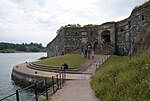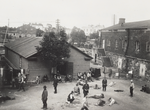Kuivasaari

Kuivasaari (Torra Mjölö in Swedish) is a Finnish island in the Gulf of Finland, near Helsinki. Kuivasaari is located some 5 kilometres (3 miles) out into the Gulf of Finland, due south of Helsinki city centre, and was for many years the outermost inhabited island in the Helsinki archipelago (now there is no permanent settlement based on the island). It lies parallel to the Harmaja lighthouse, and the main shipping route into and out of Helsinki passes between the two. In fair weather the city of Tallinn, Estonia on the southern shore of the Gulf of Finland is visible from the observation tower. The whole island is a military installation of the Finnish Defence Forces, and access for civilians is heavily restricted. A number of coastal artillery guns are installed there, including some exceptionally heavy 12-inch (305 mm) pieces. The island served as an important coastal artillery fort protecting the entrance to Helsinki harbour during the World Wars. The island gets its name, meaning 'dry island', from the fact that there is no fresh water on the island, and water is instead pumped from the nearby Isosaari island.
Excerpt from the Wikipedia article Kuivasaari (License: CC BY-SA 3.0, Authors, Images).Kuivasaari
Reimantie, Helsinki Ulkosaaret (Southeastern major district)
Geographical coordinates (GPS) Address Nearby Places Show on map
Geographical coordinates (GPS)
| Latitude | Longitude |
|---|---|
| N 60.1 ° | E 25.016666666667 ° |
Address
152/50 T turret gun
Reimantie
Helsinki, Ulkosaaret (Southeastern major district)
Finland
Open on Google Maps










